 Music
Music  Music
Music  History
History 10 Less Than Jolly Events That Occurred on December 25
 Weird Stuff
Weird Stuff 10 Funny Ways That Researchers Overthink Christmas
 Politics
Politics 10 Political Scandals That Sent Crowds Into the Streets
 Weird Stuff
Weird Stuff Ten Bizarre Facts About The Doge Meme
 Our World
Our World 10 Ways Your Christmas Tree Is More Lit Than You Think
 Movies and TV
Movies and TV The 10 Coolest Stars to Set Sail on The Love Boat
 History
History 10 Things You Didn’t Know About the American National Anthem
 Technology
Technology Top 10 Everyday Tech Buzzwords That Hide a Darker Past
 Humans
Humans 10 Everyday Human Behaviors That Are Actually Survival Instincts
 Music
Music 10 Surprising Origin Stories of Your Favorite Holiday Songs
 History
History 10 Less Than Jolly Events That Occurred on December 25
 Weird Stuff
Weird Stuff 10 Funny Ways That Researchers Overthink Christmas
Who's Behind Listverse?

Jamie Frater
Head Editor
Jamie founded Listverse due to an insatiable desire to share fascinating, obscure, and bizarre facts. He has been a guest speaker on numerous national radio and television stations and is a five time published author.
More About Us Politics
Politics 10 Political Scandals That Sent Crowds Into the Streets
 Weird Stuff
Weird Stuff Ten Bizarre Facts About The Doge Meme
 Our World
Our World 10 Ways Your Christmas Tree Is More Lit Than You Think
 Movies and TV
Movies and TV The 10 Coolest Stars to Set Sail on The Love Boat
 History
History 10 Things You Didn’t Know About the American National Anthem
 Technology
Technology Top 10 Everyday Tech Buzzwords That Hide a Darker Past
 Humans
Humans 10 Everyday Human Behaviors That Are Actually Survival Instincts
10 Historical Shoe Rituals and Superstitions You Might Not Know About
A “concealed sho” is a shoe, boot, or slipper hidden in the walls of buildings and houses, sometimes for magical purposes by builders and homeowners. Superstition and spiritual beliefs led people to put these items in secret places to ward off witches and evil spirits. Eventually, so many of these shoes were found that scholars and archaeologists came to realize that they were put there on purpose, and for eerie reasons not really understood fully today.
This ritual mainly occurred in Britain, but could also be found in the United States, Spain, China, and Australia. The shoes were found in chimney flues and eves of houses and would have been worn by children, men, and women. Many were found at the entrances of homes where protection from evil-doers might be most needed, but other theories include the idea that it might have been a builders’ tradition to place them there. This may have been related to trade in some way, or maybe it was to commemorate something lost to living memory. What was it about shoes that made people behave in such strange ways?
Related: Top 10 Misconceptions About Historical Clothing And Fashion?utm_source=seealso&utm_medium=link&utm_campaign=direct
9 Finding a Husband with Your Shoes 101
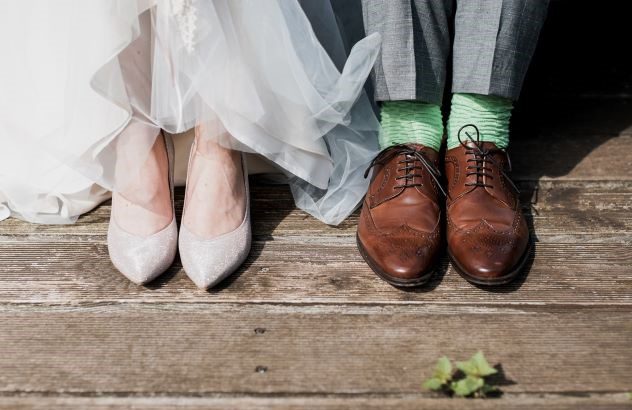
Like Cinderella’s glass slipper, Hans Christian Andersen’s red shoes, and Dorothy’s ruby slippers, shoes have always been part of folklore and fairy stories. For example, in nineteenth-century England, a young girl who wanted to dream about her future spouse would only have to place her shoes at an angle and say, “I set my shoes in the form of a T, hoping my true love to see.”
But if a girl’s shoes were untied, then her future love was already thinking about her. And by placing a clover leaf inside one of her shoes, she would ensure that the next man she met was going to be her future husband.
But it wasn’t just about husband-finding; some of the rituals were tied more closely to luck—good and bad. If a man was struck by a bolt of lightning, then his shoes must be buried right away to make sure the spiritual power in the bolt didn’t spread. If an Irish child went missing, then burying a pair of old shoes they owned would ensure the safe return of the child.
People used to believe throwing an old shoe at someone was good luck! Queen Victoria threw a shoe at soldiers about to depart for the Crimean War. Charles Dickens even included a scene in Great Expectations where Biddy and Joe threw shoes at Pip as he set off for London.[1]
9 Normal Footwear Doing Unusual Things
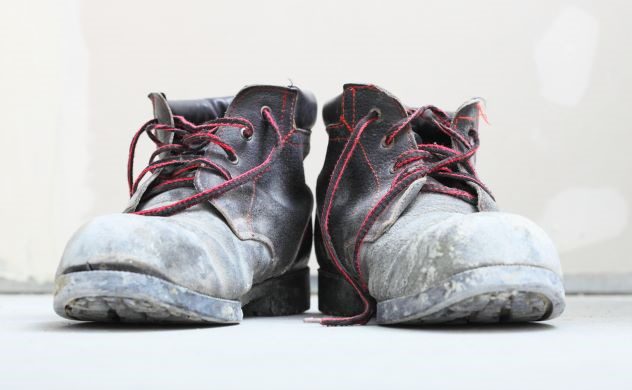
Most of the concealed shoes found in domestic places were used, everyday shoes, well-worn and bearing the shape and personality of the wearer. Unlike the historical shoes you might see in museum clothing and costume departments, the ones found in walls of barns and houses were the very opposite in style and cost. Ordinary, practical shoes were favored, and if someone came across a pair after many years of being concealed, they might simply look like a bit of old rubbish.
American pairs were of calfskin, hardy and strong, as opposed to kidskin, which would be finer and more expensive. Latchet-tie shoes were popular, referring to a narrow leather strap or fastening that attaches the shoe to the foot, as were bluchers, slit vamps, and high ankle brogans.
American men in the nineteenth century seemed to prefer Wellington boots for their concealed shoes, and women had elasticated boots for wearing at home or out and about. These hidden shoes were, however, not ones for special parties or occasions. The more ordinary, the better, as far as concealing them inside walls went.[2]
8 Magic Spells and Unsolved Murder
Anthropologists say that if an object resembles a person closely enough, then magic performed using it will become sympathetic, sometimes also called homeopathic magic. A picture of a person would work in the same way, for example. Another belief is that contagious magic involves the use of an object that was in contact with someone. So a shoe that holds the form of a foot, as well as being in contact with that person for so long, works on both levels and is a very powerful magical object.
A Scottish murder trial in 1890 tells of a local policeman who was asked in court why he buried the murdered man’s shoes in water instead of saving them as evidence for the trial. He answered that he was acting on an ancient rite that said by submerging the shoes, he would lay the ghost of the murdered man to rest. He was protecting the neighborhood from his restless spirit who could bring calamity to them all[3]
7 A Charm for Protection
Some historians believe that the use of shoes as magical charms inside buildings actually came from an earlier use of human sacrifice, providing a guardian soul to the building. But concealed shoes could also have been magical traps by presenting an equivalent to a human sacrifice and becoming a decoy to capture a witch or evil entity.
A similar phenomenon came in the form of a witch bottle, typically found in dwellings from the seventeenth and eighteenth centuries. You had to get ahold of some hair, urine, or toenail clippings, then add that to some material that you cut in the shape of a heart with some pins or nails. They were found in the openings of houses, just like the concealed shoes, like a doorway.
Any spells cast against the human in question would be reversed onto the witch. The cork or plug in the bottle caused the witch to be unable to urinate, and she would die. The magical connection between the human contents and the witch made it so any harm done to the contents caused equal harm to the witch. It is thought this process also applied to the old shoes found in the same places, so anyone who felt bewitched could possibly have immobilized the witch by stuffing their shoe into the walls.[4]
6 Cutting up Concealed Magical Shoes
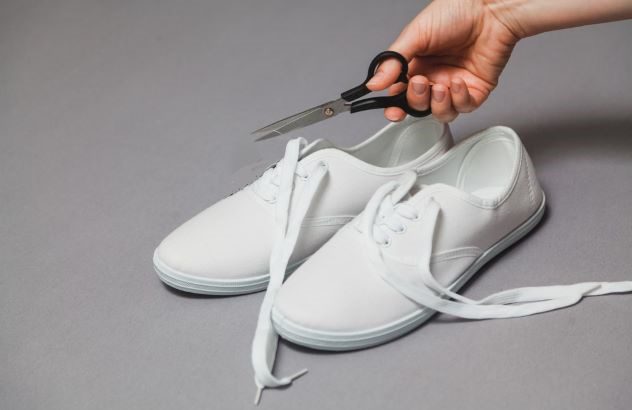
Just like the belief that a witch could be harmed by harming the shoe or bottle, cutting the shoes before they were placed was a way of possibly harming the witch who had cursed you. Of course, it might have just been cut so a woman could wear a large pair over her own smaller ones or take some leather from very old ragged pairs to make smaller new ones. However, some are ruined beyond repair. A plausible explanation is that they were destroyed to “kill” the spirit of the shoe to send it to the afterlife, like the pagan/ early Christian practice of sending things like coins and sacrifices to saints.[5]
5 Where to Find Concealed Shoes, and What Else Is There
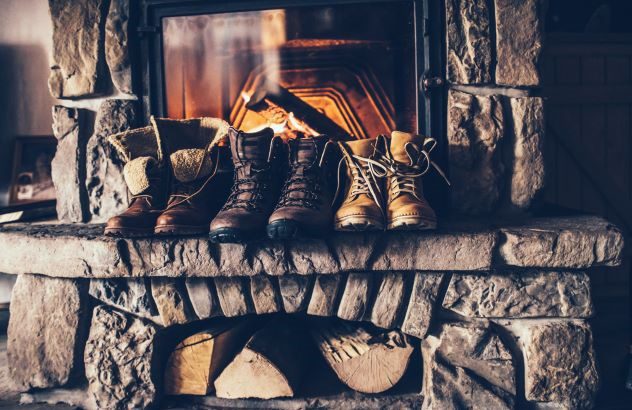
Fireplaces, chimney flues, windows, and doors were all points of entry to dwellings where concealed shoes were found: places believed to hold special interest to invading spirits. Think of how Santa comes in to deliver all the presents on Christmas Eve! The largest collection of shoes and boots came from the John Adams Birthplace Collection and comprised 44 boots and shoes.
In the home of the second president of America, single shoes, boots, and slippers from women and men were dated to 1855-1870, and 34 of those were found around the chimney and fireplace, with some belonging to children as well. It’s by far the most extensive collection ever found in the United States.[6]
4 A Secret Left Behind by Builders
It’s possible that the building trade has more to do with concealing shoes than witches and Santa. While concealing shoes might still have been a way to ward off bad luck, they might have done so as a ritual way of declaring their work finished, whether they finished the whole house or just a repair or final bit of construction.
The Bridges House in North Andover, New Hampshire, had some big renovations and remodeling in the early eighteenth century and when a later owner remarried in 1830. A lady’s shoe was found under an entryway that dated to 1790, and it’s thought to either belong to the owner’s second wife to wish her luck in her new home. Or it may have belonged to his first wife, who died in an accident, and her former husband wanted to preserve her memory.[7]
3 Did the Shoemakers Start It All
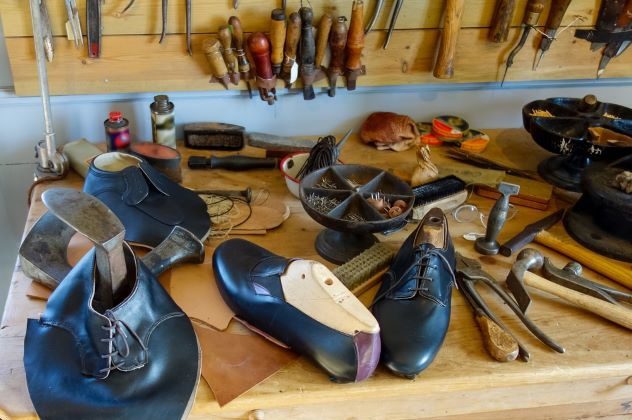
At the John Adams Birthplace house, archaeologists thought perhaps that shoemakers had performed the ritual practice of concealment after they discovered the 44 boots and shoes in the walls. Adam and Samuel Curtis were brothers and lived in the house from 1821 to 1830, and both were shoemakers. One of the Wellington boots for a child had a name written inside it, George Curtis, the son of Adam Curtis.
Perhaps the fact that shoemakers once lived inside the house where 44 shoes were found is no mystery, particularly if you understand that shoes are symbols of their livelihood, a skill that was highly invested in time, practice, and techniques honed.
There are 13 documented cases of concealed shoes in shoemakers’ homes, in a similar practice found in pre-Roman London, where artisans threw their much-needed tools into the Thames River, perhaps to appease the gods and bring luck and prosperity. It’s also possible that the stash of shoes at the Adams house was merely a place to store old bits of leather that could be used again to patch up shoes, something that would be typical of thrifty shoemakers who are known to never waste valuable leather.[8]
2 Spirit Containment by Concealing Shoes

Shoes served as mementos to those who had died, and some believed that keeping a shoe from a dead loved one in the walls was a way to keep their spirit with you in the house. In the deeds to Papillon Hall in Leicestershire, it is clearly written that the pair of slippers that once belonged to a little girl now locked away behind a screen in the house’s dining room is never to be removed. It’s thought that her grieving family was so distraught they kept it in the deeds that the shoes should always remain there.
A similar sad tale comes from the Brintal-Loker House in Massachusetts. In the nineteenth century, the family lost many children, and one was a little boy who was nearly two years old. Oscar’s small leather boot was found in the chimney, along with a sleigh bell that might have been one of his favorite toys. Here the old idea of connected magic reappears, where the shoe and how it is preserved is related to its former wearer. Anyone letting go of a loved one’s clothes today can still appreciate the connection between belongings and their former owner.[9]
1 Contemporary Magic in Richmond
The most modern concealed shoe ever found was in a home in Massachusetts built in 1908. It was a lady’s shoe that dated from the 1930s. One of the most convincing stories of modern concealed shoes comes from the twentieth century at the Putney Shoe Factory in Richmond, Virginia. The successful and prosperous shoemaking company ordered a new building in the industrial center of Richmond. There, they also found a pair of white lady’s lace-up shoes smuggled into the eaves of the building.
The juxtaposition of the ancient and modern makes for a compelling case for modern magic! But it is rare to find this ritual today. A greater understanding of medicine and technology replaced superstition when sickness came to families. And education and printed information meant a wiser public emerged from a culture of folklore and oral tradition.[10]








